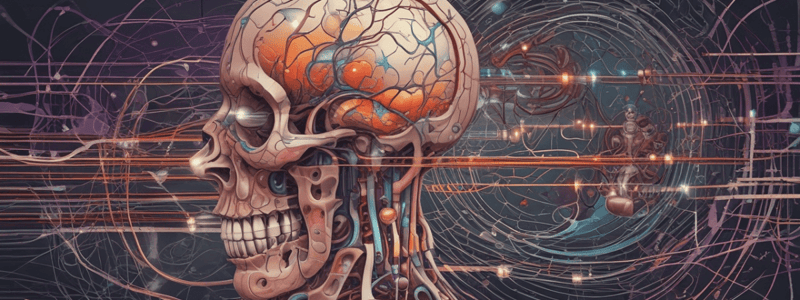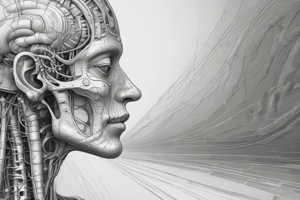Podcast
Questions and Answers
The majority of fractures occur in older adults due to sports-related injuries.
The majority of fractures occur in older adults due to sports-related injuries.
False (B)
Indirect healing involves the use of surgical procedure to realign bone.
Indirect healing involves the use of surgical procedure to realign bone.
False (B)
The EEG is used to diagnose seizure disorders.
The EEG is used to diagnose seizure disorders.
True (A)
Anterior Cruciate Ligament (ACL) injuries occur when the ligament is compressed.
Anterior Cruciate Ligament (ACL) injuries occur when the ligament is compressed.
Compartment syndrome is a non-emergency condition.
Compartment syndrome is a non-emergency condition.
Osteochondral lesions occur at the joint of the spine.
Osteochondral lesions occur at the joint of the spine.
The primary cause of Meniscus Injury is a direct blow to the knee.
The primary cause of Meniscus Injury is a direct blow to the knee.
Dislocations occur when the bones of a joint remain in partial contact.
Dislocations occur when the bones of a joint remain in partial contact.
Corticosteroid injections are used to treat bursitis.
Corticosteroid injections are used to treat bursitis.
Fat embolism syndrome occurs when fat emboli become trapped in dermal capillaries.
Fat embolism syndrome occurs when fat emboli become trapped in dermal capillaries.
Parkinson disease is a chronic, progressive, degenerative disorder that primarily affects individuals under the age of 50.
Parkinson disease is a chronic, progressive, degenerative disorder that primarily affects individuals under the age of 50.
Multiple sclerosis is a chronic, inflammatory, demyelinating, and axonal degenerative disorder of the CNS, primarily affecting men.
Multiple sclerosis is a chronic, inflammatory, demyelinating, and axonal degenerative disorder of the CNS, primarily affecting men.
Amyotrophic lateral sclerosis (ALS) is a progressive neurodegenerative disease that causes weakness, disability, and death within 10-15 years.
Amyotrophic lateral sclerosis (ALS) is a progressive neurodegenerative disease that causes weakness, disability, and death within 10-15 years.
Huntington disease is an autosomal recessive inherited disorder that causes uncontrolled involuntary movements, dementia, and behavior changes.
Huntington disease is an autosomal recessive inherited disorder that causes uncontrolled involuntary movements, dementia, and behavior changes.
Seizure disorders are classified as febrile, partial, and generalized seizures.
Seizure disorders are classified as febrile, partial, and generalized seizures.
Tonic-clonic seizures are associated with a loss of awareness or consciousness, muscle stiffness, and twitching.
Tonic-clonic seizures are associated with a loss of awareness or consciousness, muscle stiffness, and twitching.
Status epilepticus is a life-threatening condition characterized by a brief, self-limiting seizure episode.
Status epilepticus is a life-threatening condition characterized by a brief, self-limiting seizure episode.
Parkinson disease is caused by a combination of genetic and environmental factors, including exposure to pesticides and metals.
Parkinson disease is caused by a combination of genetic and environmental factors, including exposure to pesticides and metals.
Multiple sclerosis is a progressive disease with no periods of remission or plateau.
Multiple sclerosis is a progressive disease with no periods of remission or plateau.
Riluzole is a medication used to treat the symptoms of Parkinson disease.
Riluzole is a medication used to treat the symptoms of Parkinson disease.
Adhesive Capsulitis, also known as Frozen Shoulder, is a condition caused by a penetrating wound.
Adhesive Capsulitis, also known as Frozen Shoulder, is a condition caused by a penetrating wound.
Osteomyelitis is a bone infection that can be caused by bacteria, fungi, parasites, and viruses.
Osteomyelitis is a bone infection that can be caused by bacteria, fungi, parasites, and viruses.
Benign Bone Tumors are commonly found in individuals over the age of 60.
Benign Bone Tumors are commonly found in individuals over the age of 60.
Active exercising for Adhesive Capsulitis begins immediately after diagnosis.
Active exercising for Adhesive Capsulitis begins immediately after diagnosis.
Osteonecrosis is a condition characterized by the death of bone tissue due to long-term use of steroids.
Osteonecrosis is a condition characterized by the death of bone tissue due to long-term use of steroids.
Arthroscopic surgery is a common treatment for Osteomyelitis.
Arthroscopic surgery is a common treatment for Osteomyelitis.
Spinal Stenosis can cause numbness and tingling in buttocks or legs.
Spinal Stenosis can cause numbness and tingling in buttocks or legs.
Rheumatoid Arthritis primarily affects the spine.
Rheumatoid Arthritis primarily affects the spine.
Osteoporosis is characterized by an increase in bone density.
Osteoporosis is characterized by an increase in bone density.
Gout is caused by a lack of uric acid in the body.
Gout is caused by a lack of uric acid in the body.
Herniated discs are more common in people over 50 years old.
Herniated discs are more common in people over 50 years old.
Scoliosis is a condition that affects only the lower back.
Scoliosis is a condition that affects only the lower back.
Paget Disease is a genetic disorder that only affects the spine.
Paget Disease is a genetic disorder that only affects the spine.
Osteopenia is a condition that only affects older adults.
Osteopenia is a condition that only affects older adults.
Chronic musculoskeletal disorders can be caused by lifestyle choices.
Chronic musculoskeletal disorders can be caused by lifestyle choices.
Metastatic Bone Disease is a type of cancer that originates in the bones.
Metastatic Bone Disease is a type of cancer that originates in the bones.
Match the following conditions with their associated risk factors:
Match the following conditions with their associated risk factors:
Match the following conditions with their primary symptoms:
Match the following conditions with their primary symptoms:
Match the following conditions with their diagnostic methods:
Match the following conditions with their diagnostic methods:
Match the following conditions with their treatments:
Match the following conditions with their treatments:
Match the following conditions with their age range:
Match the following conditions with their age range:
Match the following conditions with their resolution time:
Match the following conditions with their resolution time:
Match the following neurodegenerative disorders with their primary clinical manifestations:
Match the following neurodegenerative disorders with their primary clinical manifestations:
Match the following disorders with their primary causes:
Match the following disorders with their primary causes:
Match the following disorders with their primary diagnostic tests:
Match the following disorders with their primary diagnostic tests:
Match the following seizures with their characteristics:
Match the following seizures with their characteristics:
Match the following neurodegenerative disorders with their primary treatment options:
Match the following neurodegenerative disorders with their primary treatment options:
Match the following disorders with their primary age of onset:
Match the following disorders with their primary age of onset:
Match the following disorders with their primary risk factors:
Match the following disorders with their primary risk factors:
Match the following disorders with their primary neurological manifestations:
Match the following disorders with their primary neurological manifestations:
Match the following disorders with their primary stages:
Match the following disorders with their primary stages:
Match the following disorders with their primary complications:
Match the following disorders with their primary complications:
Match the following musculoskeletal disorders with their primary causes:
Match the following musculoskeletal disorders with their primary causes:
Match the following treatment options with their corresponding conditions:
Match the following treatment options with their corresponding conditions:
Match the following clinical manifestations with their corresponding conditions:
Match the following clinical manifestations with their corresponding conditions:
Match the following complications with their corresponding conditions:
Match the following complications with their corresponding conditions:
Match the following diagnostic tests with their corresponding conditions:
Match the following diagnostic tests with their corresponding conditions:
Match the following risk factors with their corresponding conditions:
Match the following risk factors with their corresponding conditions:
Match the following treatment options with their corresponding conditions:
Match the following treatment options with their corresponding conditions:
Match the following conditions with their corresponding descriptions:
Match the following conditions with their corresponding descriptions:
Match the following clinical manifestations with their corresponding conditions:
Match the following clinical manifestations with their corresponding conditions:
Match the following surgical procedures with their corresponding conditions:
Match the following surgical procedures with their corresponding conditions:
Match the following musculoskeletal disorders with their primary symptoms:
Match the following musculoskeletal disorders with their primary symptoms:
Match the following conditions with their primary causes:
Match the following conditions with their primary causes:
Match the following diseases with their primary effects on the body:
Match the following diseases with their primary effects on the body:
Match the following conditions with their primary risk factors:
Match the following conditions with their primary risk factors:
Match the following conditions with their primary diagnostic tests:
Match the following conditions with their primary diagnostic tests:
Match the following conditions with their primary treatment options:
Match the following conditions with their primary treatment options:
Match the following conditions with their primary symptoms in the limbs:
Match the following conditions with their primary symptoms in the limbs:
Match the following conditions with their primary effects on daily life:
Match the following conditions with their primary effects on daily life:
Match the following conditions with their primary age ranges:
Match the following conditions with their primary age ranges:
Match the following conditions with their primary risk factors:
Match the following conditions with their primary risk factors:
Flashcards are hidden until you start studying



